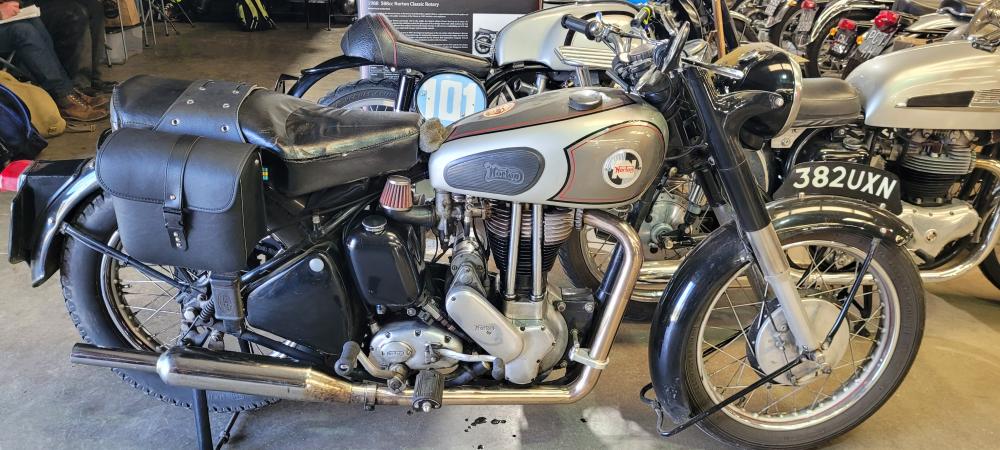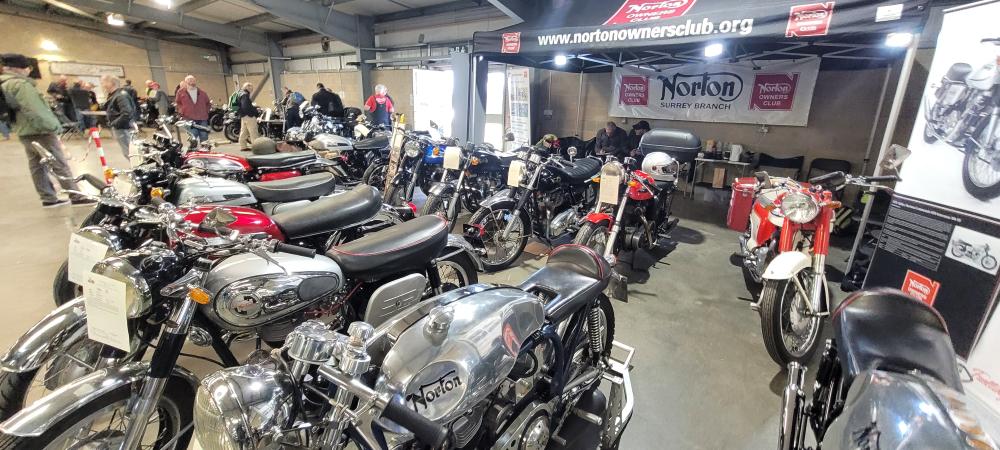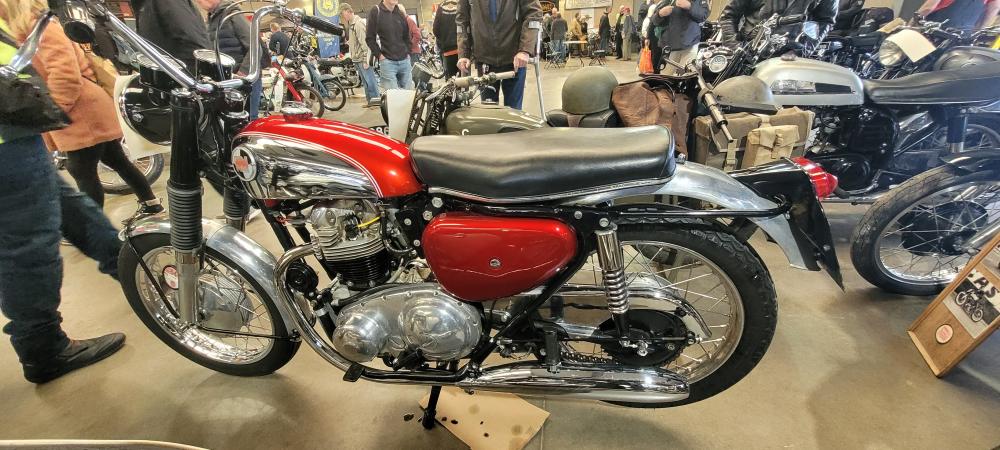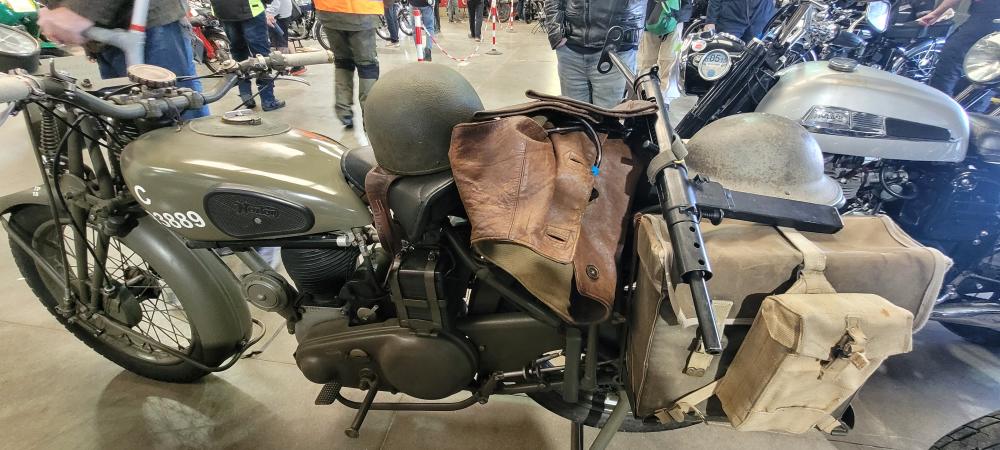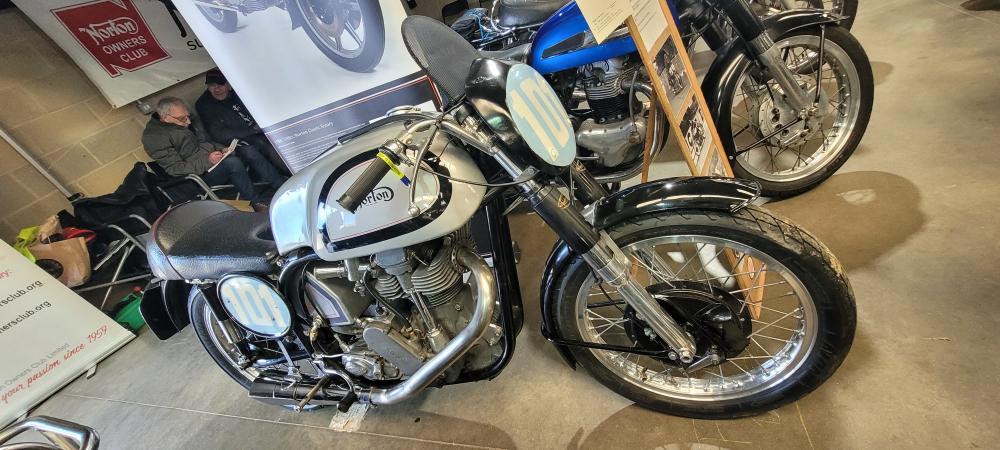1898 to 1939
|
James Lansdowne Norton was born in Birmingham in 1869, the son of a cabinet maker. As a boy he showed an early aptitude for mechanical devices and upon finishing his education was apprenticed to a toolmaker in the jewellery trade. In 1898 he started the Norton Manufacturing Co. to make chains and other items for bicycles. The first Norton motorcycle was produced in 1902, a bicycle with a Belgian Clement engine on the front down tube. A Norton with a Peugeot engine won the first TT in 1907, ridden by Rembrandt Fowler who had to overcome several punctures and spark plug changes. By 1909 a range of eight models was offered for sale, two with bought in engines, six with Norton engines. Harrods were early London agents. Norton was a good engineer but the business struggled and was on the verge of insolvency in 1913 when R.T. Shelley & Co., the main creditors stepped in and saved it. Norton Motors Ltd. was formed. Brooklands was becoming established as a speed and testing centre at this time. R.T. Shelley's brother in law was the ace tuner Dan O'Donovan so new engines were sent along for testing by him in a rolling chassis known as 'Old Miracle', holder of many speed records and now preserved in a museum. Tested engines were not offered for sale until the appropriate performance was obtained. A government contract was secured in WW1 for supplying machines to the Russian army and in 1916 a move to a larger premises in Bracebridge Street, Aston was made. The famous curly Norton logo appeared around this time. The pre-war belt drive machines continued for a while after cessation of hostilities in 1918 in the guise of the Brooklands Special, certified to have achieved 75mph over one kilometre at Brooklands, and the Brooklands Road Special with only a slightly less sparkling performance figure. The latter was often supplied with a Philipson pulley variable gear on the end of the crankshaft, enabling the rider to keep the engine running in slow-moving traffic. The long lived 633cc side valve Big 4 with all chain drive had been introduced in 1908 and continued after the war as a mainstay of the five model range, as it was to be until after WW2. The factory's involvement with racing was taken up again with the first post-war TT races in 1920; a side valver with three speeds and chain drive was taken to second place in the Senior. Another Norton was ridden the last thirty miles without any balls in the rear hub bearings and still finished eleventh. It was the last belt drive machine ever to finish a TT race. As early as 1913, 'Pa' Norton had talked of overhead valves with desmodromic operation, but it was not until 1922 that he produced his first OHV machine, the Model 18. The OHV made little impact at the 1922 TT but before the year was out it had firmly established itself as one of the quickest singles around. In 1923 the Maudes Trophy was gained for the first time when an 'off the shelf' Model 18 broke eighteen world records at Brooklands, ridden by a team consisting of O'Donovan, Bert Denly and Nigel Spring. The trophy was to be retained for a further three years after similar feats of speed and endurance. By 1924 other familiar model names such as 16H and Model 19 had been introduced, the latter being a 588cc version of the Model 18. They also had a prototype 250cc OHV on test but as the factory was hard pushed to keep up with orders for the existing range it was never produced. Alec Bennett won the Senior TT with an OHV Norton, averaging over 60mph for the first time. James Norton died in 1925 at the age of 56, though his grandfatherly appearance in photographs with silver hair and wire rimmed spectacles gave the impression of one far older. He was respected throughout the industry for his engineering ability and integrity. Shortly before his death he had taken a long holiday in South Africa upon the advice of his doctor and from the road conditions he saw there the export or 'Colonial' models were given a higher ground clearance along with various other suitable modifications. Meanwhile, on the race tracks of Europe, Norton were establishing themselves as a force to be reckoned with, winning many races and being well placed in others; shades of things to come. About this time Norton introduced the saddle type petrol tank on their racing machines. The road bikes had to wait a year or two for this, but at the 1926 London show, four speed gearboxes and internal expanding brakes were standard equipment on several models along with automatic primary drive chain lubrication. The company was financially reconstructed during the year and the name changed to Norton Motors (1926) Ltd. A young Irishman called Stanley Woods won the 1926 Senior TT on a Norton, but for racing purposes the pushrod engine was on the verge of being superseded by a new development. The Walter Moore designed overhead camshaft engine retained the classic Norton dimensions of 79 by 100mm but the similarity ended there. The drive from the crankshaft was taken through a set of bevels, thence by an enclosed vertical shaft to the cambox via another bevel set. The cambox was bolted to the cylinder head and the valves returned by coil springs. A new frame was also introduced, a cradle type with single top and front down tubes. The exhaust pipe was to the left of the machine, the Norton practice at the time. In 1928 the new frame was also used to house the pushrod engine with the model designation of ES2 being used. There has been some speculation in recent years as to what the ES stood for, but 'Enclosed Springs" is perhaps the most likely. Bennett won the 1927 Senior TT on the OHC machine after Woods was forced to retire with clutch trouble when holding a commanding lead on a similar machine. Other manufacturers supporting racing teams promptly rushed off to wring more power from their own machines and Norton's power advantage was quickly pulled back. The day of the Norton had not quite arrived, but it was close at hand. Also in 1927 Bert Denly took a pushrod machine to Montlhéry in France and raised the 500cc one hour record to over 100 miles for the first time; the last occasion it was held by an OHV engine. Following the successful introduction of the CS1 it was a logical step to make a 350cc version and this was duly done in 1928 with the CJ. Walter Moore left Norton in 1929 to work for NSU in Germany. He personally owned the design of the OHC engine so it was no surprise when NSU started to produce a very similar engine some time thereafter. Norton were naturally not overjoyed about this and promptly got Arthur Carroll to redesign the OHC engine. He produced what became one of the most dominant racing engines of all time with a glittering career that lasted for the next twenty-five years apart from occasional rude incursions by Velocette, Guzzi, Gilera and BMW. On the road machines, cellulose paint and chrome plating arrived in 1930 along with dry sump lubrication, light alloy pistons and much shorter wheelbases. The OHV speedway machine was dropped from the range, being unable to break the Douglas and Rudge supremacy in this field. The company name was changed back to Norton Motors Ltd. Woods and Tim Hunt dominated the 1931 racing scene on the works Nortons, sharing many dramatic finishes. Over the next few years, riders such as Guthrie, Frith, Simpson and Daniell also took Norton to an almost countless number of victories. The racing team was of course under the management of Joe Craig, the chief development engineer. An Ulsterman, he joined Norton in 1926 as a rider/engineer and exerted his Svengali like influence until 1955 apart from a six year spell at AJS from 1939-45. In 1932 Bill Lacey raised the one hour record to 110mph at Montlhéry. The Model 50 was announced, along with its twin port brother the Model 55. A four speed gearbox was standard, with either hand or foot changes as required by the customer. The wheels were Q.D. and interchangeable. The silencer was a semi-Brooklands can. An instrument panel was recessed into the petrol tank. Price was £53 for the 50 and £2 extra for the twin port version. The OHC International models also made their debut and for a few years were updated to 'last years works model' spec. to make them competitive with most other private machines. The CS1 and CJ continued as road equipped versions. The famous (or infamous) Norton oil bath primary chaincase arrived in 1934 and stayed until 1970. Norton were now making their own gearboxes. The new cradle frame was available on most models. The Inters now had hairpin valve springs which could be changed without the inconvenience of removing the cylinder head. Plunger rear suspension appeared on the works racers in 1936 and the following year saw the DOHC engine, with the huge finning on the upper parts, on the racing scene along with a newly designed conical front brake. In August 1937 the great Jimmy Guthrie was killed at Chemnitz in Germany as a result of a crash when trying to snatch victory from a supercharged BMW. A statue was erected to his memory in his home town of Hawick and even in Nazi Germany, a memorial was placed at the spot where he crashed. On the road machines the electrical systems were revised somewhat and the OHV models now had a 14mm spark plug. In 1938 the Manx Grand Prix racer was offered for sale. This was basically an Inter with all the latest go faster goodies except the DOHC engine. It had the plunger frame, conical hubs, and a big finned head. The plunger frame was an option on the Inter models and a most hideous silencer was put onto the OHV machines for just the one year. The portly Harold Daniell won the Senior TT at over 90mph but with other teams using supercharged engines he probably did not have the fastest machine around. Had world events not taken over, the single pot machine could well have been eclipsed totally in the early forties. The Works team was mothballed for 1939 and with a war just months away the factory was turned over to producing the military version of the 16H. This used the 1937 engine with open valve gear and a high ground clearance frame with crankcase shield. The Big 4 was called up for sidecar service and featured sidecar wheel drive. As civilian motorcycling was six years distant at this point, it forms a natural break with which to suspend this narrative. |
© Norton Owners Club 1996
Originally published in the Norton Owners Club Classic Calendar for 1986

